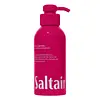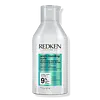What's inside
What's inside
 Key Ingredients
Key Ingredients

No key ingredients
 Benefits
Benefits

 Concerns
Concerns

 Ingredients Side-by-side
Ingredients Side-by-side

Water
Skin ConditioningCocamidopropyl Betaine
CleansingSodium Cocoyl Isethionate
CleansingDecyl Glucoside
CleansingCocamidopropyl Hydroxysultaine
CleansingParfum
MaskingOrbignya Speciosa Kernel Oil
EmollientAstrocaryum Murumuru Seed Butter
EmollientSalvia Hispanica Seed Extract
EmollientLinum Usitatissimum Seed Extract
PerfumingCocos Nucifera Water
MaskingPanthenyl Hydroxypropyl Steardimonium Chloride
Phenoxyethanol
PreservativePolyquaternium-10
PEG-150 Distearate
EmulsifyingPolyquaternium-7
Ethylhexylglycerin
Skin ConditioningCitric Acid
BufferingTetrasodium Glutamate Diacetate
Hexyl Cinnamal
PerfumingCoumarin
PerfumingWater, Cocamidopropyl Betaine, Sodium Cocoyl Isethionate, Decyl Glucoside, Cocamidopropyl Hydroxysultaine, Parfum, Orbignya Speciosa Kernel Oil, Astrocaryum Murumuru Seed Butter, Salvia Hispanica Seed Extract, Linum Usitatissimum Seed Extract, Cocos Nucifera Water, Panthenyl Hydroxypropyl Steardimonium Chloride, Phenoxyethanol, Polyquaternium-10, PEG-150 Distearate, Polyquaternium-7, Ethylhexylglycerin, Citric Acid, Tetrasodium Glutamate Diacetate, Hexyl Cinnamal, Coumarin
Water
Skin ConditioningSodium Cocoyl Isethionate
CleansingDecyl Glucoside
CleansingCocamidopropyl Betaine
CleansingSorbitol
HumectantCitric Acid
BufferingHydroxyethyl Urea
HumectantPotassium Hydroxide
BufferingPotassium Cocoyl Glycinate
PPG-5-Ceteth-20
EmulsifyingPanthenol
Skin ConditioningSodium Benzoate
MaskingHydroxypropyl Guar Hydroxypropyltrimonium Chloride
Sodium Chloride
MaskingPEG-55 Propylene Glycol Oleate
Propylene Glycol
HumectantParfum
MaskingCaprylyl Glycol
EmollientAcrylates/C10-30 Alkyl Acrylate Crosspolymer
Emulsion StabilisingPEG-150 Distearate
EmulsifyingPolyquaternium-10
Potassium Cocoate
EmulsifyingCoco-Caprylate/Caprate
EmollientSalicylic Acid
MaskingGlycol Distearate
EmollientButyrospermum Parkii Butter
Skin ConditioningPersea Gratissima Oil
Skin ConditioningLimonene
PerfumingGlycine
BufferingCoco-Betaine
CleansingLinalool
PerfumingTocopherol
AntioxidantHelianthus Annuus Seed Oil
EmollientRosmarinus Officinalis Leaf Extract
AntimicrobialWater, Sodium Cocoyl Isethionate, Decyl Glucoside, Cocamidopropyl Betaine, Sorbitol, Citric Acid, Hydroxyethyl Urea, Potassium Hydroxide, Potassium Cocoyl Glycinate, PPG-5-Ceteth-20, Panthenol, Sodium Benzoate, Hydroxypropyl Guar Hydroxypropyltrimonium Chloride, Sodium Chloride, PEG-55 Propylene Glycol Oleate, Propylene Glycol, Parfum, Caprylyl Glycol, Acrylates/C10-30 Alkyl Acrylate Crosspolymer, PEG-150 Distearate, Polyquaternium-10, Potassium Cocoate, Coco-Caprylate/Caprate, Salicylic Acid, Glycol Distearate, Butyrospermum Parkii Butter, Persea Gratissima Oil, Limonene, Glycine, Coco-Betaine, Linalool, Tocopherol, Helianthus Annuus Seed Oil, Rosmarinus Officinalis Leaf Extract
Ingredients Explained
These ingredients are found in both products.
Ingredients higher up in an ingredient list are typically present in a larger amount.
Citric Acid is an alpha hydroxy acid (AHA) naturally found in citrus fruits like oranges, lemons, and limes.
Like other AHAs, citric acid can exfoliate skin by breaking down the bonds that hold dead skin cells together. This helps reveal smoother and brighter skin underneath.
However, this exfoliating effect only happens at high concentrations (20%) which can be hard to find in cosmetic products.
Due to this, citric acid is usually included in small amounts as a pH adjuster. This helps keep products slightly more acidic and compatible with skin's natural pH.
In skincare formulas, citric acid can:
While it can provide some skin benefits, research shows lactic acid and glycolic acid are generally more effective and less irritating exfoliants.
Most citric acid used in skincare today is made by fermenting sugars (usually from molasses). This synthetic version is identical to the natural citrus form but easier to stabilize and use in formulations.
Read more about some other popular AHA's here:
Learn more about Citric AcidCocamidopropyl Betaine is a fatty acid created by mixing similar compounds in coconut oil and dimethylaminopropylamine, a compound with two amino groups.
This ingredient is a surfactant and cleanser. It helps gather the dirt, pollutants, and other impurities in your skin to be washed away. It also helps thicken a product and make the texture more creamy.
Being created from coconut oil means Cocamidopropyl Betaine is hydrating for the skin.
While Cocamidopropyl Betaine was believed to be an allergen, a study from 2012 disproved this. It found two compounds in unpure Cocamidopropyl Betaine to be the irritants: aminoamide and 3-dimethylaminopropylamine. High-grade and pure Cocamidopropyl Betaine did not induce allergic reactions during this study.
Learn more about Cocamidopropyl BetaineDecyl Glucoside is a glucose-based surfactant and emulsion stabilizer. It is created by reacting glucose with the fatty acids from plants.
Surfactants help clean the skin by trapping oil, sebum, and dirt to be washed away. As an emulsion stabilizer, it stabilizes the ingredients in a product by preventing them from separating.
This ingredient is biodegradable and non-toxic. This ingredient is commonly found in baby shampoos.
Decyl Glucoside is sometimes used to stabilize the UV filter Tinosorb.
Learn more about Decyl GlucosideParfum is a catch-all term for an ingredient or more that is used to give a scent to products.
Also called "fragrance", this ingredient can be a blend of hundreds of chemicals or plant oils. This means every product with "fragrance" or "parfum" in the ingredients list is a different mixture.
For instance, Habanolide is a proprietary trade name for a specific aroma chemical. When used as a fragrance ingredient in cosmetics, most aroma chemicals fall under the broad labeling category of “FRAGRANCE” or “PARFUM” according to EU and US regulations.
The term 'parfum' or 'fragrance' is not regulated in many countries. In many cases, it is up to the brand to define this term.
For instance, many brands choose to label themselves as "fragrance-free" because they are not using synthetic fragrances. However, their products may still contain ingredients such as essential oils that are considered a fragrance by INCI standards.
One example is Calendula flower extract. Calendula is an essential oil that still imparts a scent or 'fragrance'.
Depending on the blend, the ingredients in the mixture can cause allergies and sensitivities on the skin. Some ingredients that are known EU allergens include linalool and citronellol.
Parfum can also be used to mask or cover an unpleasant scent.
The bottom line is: not all fragrances/parfum/ingredients are created equally. If you are worried about fragrances, we recommend taking a closer look at an ingredient. And of course, we always recommend speaking with a professional.
Learn more about ParfumPeg-150 Distearate is an emulsifier and thickening agent. It is created from stearic acid.
As an emulsifier, peg-150 distearate helps other ingredients dissolve. This helps prevent ingredient separation.
This ingredient may not be Malassezia folliculitis, or fungal-acne safe.
Learn more about PEG-150 DistearatePolyquaternium-10 is an ammonium salt of hydroxyethylcellulose. It is a white and granular powder used as a film-former and anti-static agent.
This ingredient is commonly found in hair conditioning products. According to a manufacturer, its positive charge makes it great for absorbing hair proteins. The manufacturer also states this ingredient helps with curl retention.
For haircare friends: this ingredient is not a silicone.
Learn more about Polyquaternium-10Sodium cocoyl isethionate is a natural ingredient from coconut oil. It is an ultra gentle cleanser that gives a nice foam without drying the skin or impacting the skin barrier.
The amount of foam created depends on the amount of sodium cocoyl isethionate used in the product.
This ingredient also helps improve the spreadability of a product.
Learn more about Sodium Cocoyl IsethionateWater. It's the most common cosmetic ingredient of all. You'll usually see it at the top of ingredient lists, meaning that it makes up the largest part of the product.
So why is it so popular? Water most often acts as a solvent - this means that it helps dissolve other ingredients into the formulation.
You'll also recognize water as that liquid we all need to stay alive. If you see this, drink a glass of water. Stay hydrated!
Learn more about Water